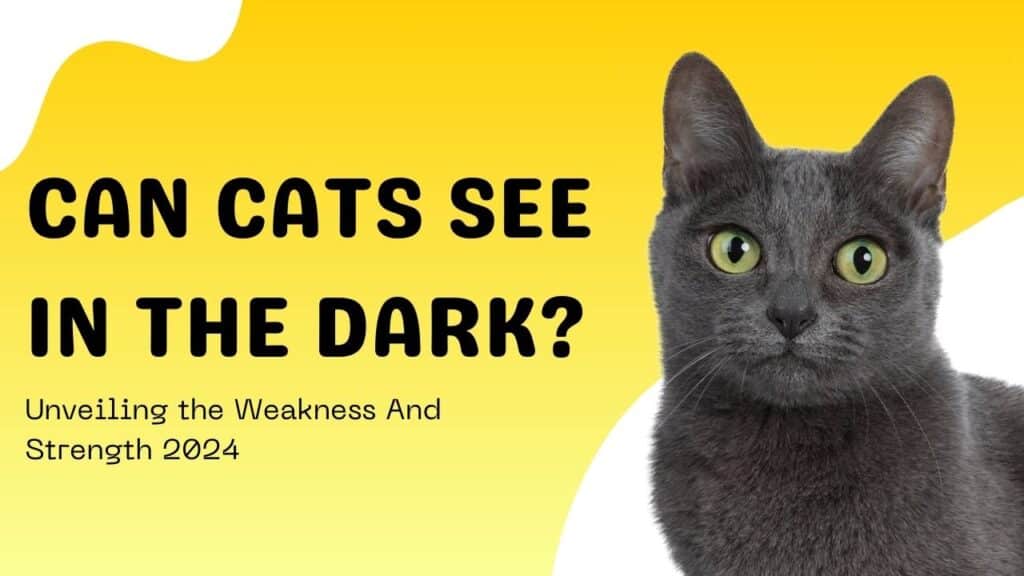Last Updated on March 30, 2024 by themubbi63
Can cats see in the dark is a question that many pet owners might have. And the answer to that is complicated. No, cats actually can’t see in pitch dark but they’re very good at low light. It’s an evolutionary trait that helped them hunt and gave them an advantage over their prey. So unless you’re in a room where there’s zero light (and what are the chances of that), your cat will probably be able to see you. Their eyes are built differently than ours.
Night Vision of Cats
A common misconception about cats? They’re nocturnal animals. This actually isn’t true at all. They’re crepuscular animals which means that historically they hunted at dawn and dusk. They can see very well in low light which is what gives us the idea that cats can see in the dark. It’s because their eyes are peculiarly adapted to see in the dark.
Pupils and Corneas
Now, the first thing that allows the cat to see in very dim light are their large pupils and corneas. They’re around 50 percent larger than that of human beings. If you’ve seen a cat in bright daylight, you might notice the slit-like pupils. That’s a deliberate reflex on the part of the cat to filter out excess light.
In the dark, the pupils expand to saucer-like sizes, allowing them to see quite well. The curved cornea and large lens also helps with this. Studies show that when the pupils of the cat expand to full circles, they can see in very dim light. But their vision might be quite blurry. Additionally, cats are capable of adapting their eyes to see wider ranges of light than humans are.
Related Article: Savannah Cat Size Secrets: Comparison, Growth & Facts 2024
Photoreceptors
Apart from the pupils, the photoreceptors in a cat’s eyes are completely different from humans. Cats have many more rods in their eyes, which is responsible for vision in low light and for peripheral vision. These rods help with their night vision but make it more difficult for them to see in bright light.
Cat also have a layer of reflective tissue in their eyes which reflects a lot of the available light back into the retina. If you’ve seen a cat’s eyes glowing in a photograph or in your car’s headlights, it’s this reflective tissue that is responsible.
History and Evolution
Now that we know cats see better in low light, it’s important to acknowledge the history of that. Cats were domesticated a long, long time ago, back by the ancient Egyptians 4000 years ago. But 4000 years is a drop in the bucket of evolution. Before that, your little feline’s ancestors were hunters. (Cats today still haven’t lost that instinct as any cat owner who has received gifts of dead mice or birds might know.)
Cats were solitary hunters and they hunted by ambushing their opponents. They weren’t always the biggest animals around so they had to do the best that they could. Hunting at dawn or dusk, when the light was lower and their prey’s vision was off, was one of the ways that the cat adapted to its environment.
The vertical pupils help the cat to focus. It’s something that taller felines like tigers and lions don’t have because they don’t need it. But for the shorter cat, it’s very necessary to figure out just how far the prey is.
Related article: Clouded Leopard Size Guide: Not Your Average Cat – Facts and Fun 2024
Cats Vs Humans Night Vision
Cats don’t have magical, built-in night vision goggles. They may require one-sixth the amount of light to see that we do but they do require some. No matter how dark our home might seem to us with all the lights shut off, there’s very rarely true darkness. Some light usually filters in from outside which allows our feline companions to function quite well.
Cats, unlike us, see mostly in shades of grey, blue and black. (Studies show that they seem to find shades of red and pink confusing.) This helps them when they’re trying to see in low light. The next time you enter a dark room and can’t see your kitty, rest assured that it can probably see you. It might not be in the rich way that you see the world but it’s a different perspective.
Nearsightedness
Finally, cats might be able to see better than us in low light but cats can’t really see far into the distance. Their peripheral vision is very good and they have a much wider field of vision than humans do (200 degrees for cats vs 180 degrees for humans). But they can’t see objects that are far away.
Humans can see five times the distance that cats can. And the world can at times feel quite blurry for your little kitty. But any kind of small movement or shadow near them, they’re much quicker to pick up on than you are.
Conclusion
Cats are masters of dim light! Their eyes, with large pupils and special receptors, allow them to see in ways we can’t. While not true night vision, it’s a superpower that helped them become stealthy hunters throughout history.
FAQs
Do cats see better than humans in all light conditions?
At night, yes! But cats struggle with bright light and distance vision compared to humans.
How do cat eyes help them see at night?
Large pupils, curved corneas, and special photoreceptors all contribute to their impressive night vision.
Can cats see in total darkness?
Nope! Cats need some light, but much less than us. Their eyes are built for low light, not complete darkness.
